By
Recuerdo - The tango piece “Recuerdo”, a family secret

he tango piece “Recuerdo” was born at a time when the genre grew and evolved constantly, when the inspiration of the composers seemed infinite, so much so that today it would be difficult to choose a «hinge», a milestone, from which one concludes that there is a time before and a time after some or other piece.
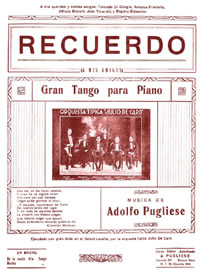 However, we can say that “Alma de bohemio” (1914) by Roberto Firpo is an indubitable mark of an avant-garde creation because of the originality of its melodic structure and the complex density of its music that foretell us the appearance of a tango more polished, of a modern tango. The same happens with “Recuerdo” ten years later, with the difference that it bore lyrics almost since its inception and these words also influenced, finally, on the musical result of the piece. Let us remember that the lines by Juan Andrés Caruso for “Alma de bohemio” date back to 1929, that is to say, fifteen years after its creation.
However, we can say that “Alma de bohemio” (1914) by Roberto Firpo is an indubitable mark of an avant-garde creation because of the originality of its melodic structure and the complex density of its music that foretell us the appearance of a tango more polished, of a modern tango. The same happens with “Recuerdo” ten years later, with the difference that it bore lyrics almost since its inception and these words also influenced, finally, on the musical result of the piece. Let us remember that the lines by Juan Andrés Caruso for “Alma de bohemio” date back to 1929, that is to say, fifteen years after its creation.
“Recuerdo” is another turning point in the development of composition in tango. For many, it is the best piece in the history of tango, not only because of its aesthetic charms but also because it opened new perspectives in composition.
But “Recuerdo” has a very special, delicate, story, that unfolds along the enigmatic canyons hand in hand with familiar relations and, especially, if we take into account the fact that we are referring to one of the greatest artists in tango: maestro Osvaldo Pugliese.
The issue is not at all simple, it not only refers to the identity of the composer, but also to the origin of its melodic variation and documentary context (sheet music and records).
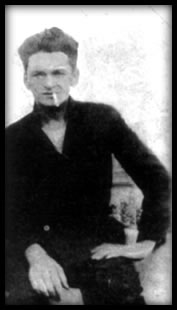 The tango piece was published in 1924 only mentioning that the music belongs to Adolfo Pugliese. A release with the Eduardo Moreno’s lyrics was published months later.
The tango piece was published in 1924 only mentioning that the music belongs to Adolfo Pugliese. A release with the Eduardo Moreno’s lyrics was published months later.
The sheet music in its lower right corner: «Sole authorized publisher. A. Pugliese. Acevedo 220. U.T.65, Chacarita 2260».
The conclusions of the many researchers that analyzed the issue are varied and contradictory. Some opinions do not consider important the fact that the piece was signed by Osvaldo’s father and based on circumstantial reasons justify it.
Luis Adolfo Sierra mentions some previous works composed by Osvaldo: «The tango titled “Primera categoría”... will be followed later, almost without interruption, by “El frenopático”, “Gauchita sentimental”... All antecedents and maybe precursors of its fundamental work which is the tango “Recuerdo”... the seminal instrumental tango which means a breakthrough in style and innovation ever composed. It was premiered by the quartet led by the bandoneonist Juan Fava at the Mitre café of Villa Crespo». And in a footnote he added: «As for the mistake so widely spread —because it appeared on the early issues of the tango “Recuerdo”— that the composer of the piece was Adolfo Pugliese, it is worthwhile clearing out that it was simply an action agreed by the publisher and Osvaldo Pugliese’s father since his son was a minor —he was only 19— when the legal protection of copyrights were not yet in force». And at the end he underlines: «... no one in good faith would question who’s the true author». (La historia del tango, volume 14, editorial Corregidor)
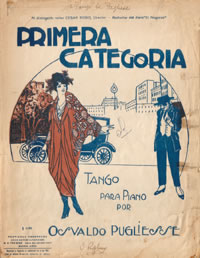 The collector Osvaldo Firpo says a quite similar thing: «It was published under don Adolfo Pugliese’s name, Osvaldo’s father, because his son was a minor. Time later father and son went together to definitively file the tango under the composer’s name in the record of the Society of Authors and Composers».
The collector Osvaldo Firpo says a quite similar thing: «It was published under don Adolfo Pugliese’s name, Osvaldo’s father, because his son was a minor. Time later father and son went together to definitively file the tango under the composer’s name in the record of the Society of Authors and Composers».
Roberto Selles holds that the reason was of financial nature and he came to know about it in an interview to the maestro, in which the latter told him that he gave the tango to his father because he had trouble in his job and had scarce money then.
Oscar del Priore and Irene Amuchástegui seem to have the same opinion when they cite a talk held between the musician and the writer Arturo Lozza: «But at that time my father had a drawback in his career as musician, flutist... Then my dad started to work selling sheet music.... One evening..., dad suggested me to publish it. OK, publish it, take it, what would I want it for?» (Cien tangos fundamentales, by Oscar del Priore and Irene Amuchástegui, editorial Aguilar.)
According to Horacio Ferrer the issue is absolutely irrelevant, but he is certain of the fact that the piece belongs to Osvaldo, because of its structure, its quality, its style. He disqualifies all those who mention other authors and emphasizes the fact that it is a tango much too important to have been made by an unknown person, with an unknown career as composer. For Ferrer it is unimportant the reason that led his father to file it in the record.
Up to this place this is the «official» version. But other researchers, that are based on documentary elements or that interviewed personalities in those years, think differently.
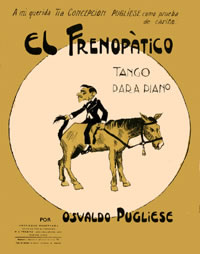 The collector Bruno Cespi doubts seriously about who the composer was and rejects the excuse that Pugliese was a minor because he owns three sheet music copies: “Primera categoría”, “Carlitos” and “El frenopático” (1922-1923), all of them previous and published under this name.
The collector Bruno Cespi doubts seriously about who the composer was and rejects the excuse that Pugliese was a minor because he owns three sheet music copies: “Primera categoría”, “Carlitos” and “El frenopático” (1922-1923), all of them previous and published under this name.
This opinion is shared by Héctor Lucci. He adds that not only the published written music bore his father's name but also the records did. The first recording of “Recuerdo” was made by the Julio De Caro Orchestra on December 9, 1926 as an instrumental. In 1927 the female singer Rosita Montemar recorded its first version with lyrics, accompanied by the staff musicians of the Victor company. The Bianco-Bachicha Orchestra cut it as an instrumental in Paris in 1928. And in 1930 the Orquesta Típica Victor, with Roberto Díaz on vocals. The name A. Pugliese appears on all the record labels. Furthermore, so still appears on the disc RCA-Victor 39776 corresponding to Ricardo Tanturi's rendition of 1942.
According to Néstor Pinsón, the tango belongs to his brother, Vicente Salvador Pugliese Fito, a violinist who did not have good relations with his father. Fito criticized his father because he was always after women and was a heavy drinker, and also because he over-protected his brother Osvaldo. He was called Fito simply because he was Adolfo's son (Adolfito). One day he went away from his parents' home and moved to the southern region of the country leaving behind the manuscript of his written music.
The person who told him this is a great bandoneonist and leader. He also remembers that he was at the ABC café with Eduardo Moreno when the violinist Emilio Marchiano aka El Rengo, turned up to ask the lyricist to go to Fito's place to add lyrics to a tango. He ends his story by saying that that brother never came back home and died in Mar del Plata.
Eduardo Moreno (1906-1997), author of its lyrics, told him the same story, plenty of details: «...one of the reasons for Fito's quarrels with his father was that when Osvaldo was a kid he was somewhat sickly, very skinny and weak. He blamed don Adolfo for this because the latter used to go out with women and every now and then he caught some disease by sexual transmission. Their father's behavior was the reason for his son's problems. So one day Fito ran away from home, gave up his violin, left everything behind. Well... the music of “Recuerdo” was his».
But the thing is not over yet. The famous final variation, which provides that masterful touch to the piece, would not either belong to Osvaldo. It was written a little time later when the words were added and it belongs to the bandoneonist Enrique Pollet, aka El Francés, (1901-1973) in collaboration with Eduardo Moreno. The adaptation of the lyrics to the music forced them to reshape as well other portions of the tango piece. The source for this statement is the same musician mentioned above, who collected this information from Pollet himself and asked me not to mention his name.
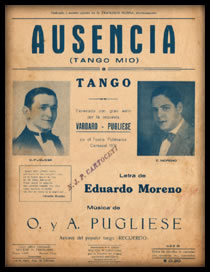 When we researched Osvaldo's sheet music subsequent to “Recuerdo” we found a curiosity. In all them it is said that the composer is the same one as in “Recuerdo”. But in the tango “Ausencia [c]” of 1931 the same composer is mentioned but the name A. Pugliese is added.
When we researched Osvaldo's sheet music subsequent to “Recuerdo” we found a curiosity. In all them it is said that the composer is the same one as in “Recuerdo”. But in the tango “Ausencia [c]” of 1931 the same composer is mentioned but the name A. Pugliese is added.
On the many occasions that maestro Pugliese was asked about this issue, he narrated how he had been developing its melody while traveling on the streetcar. He told us that this number was much liked at home. He explained the reason for its title; at the beginning it was “Recuerdo para mis amigos” (Memory for my friends), which he later shortened when it was published, adding the subtitle “A mis amigos”, as homage to the boys who used to meet at the café called La Cueva del Chancho (The Pig's Cave) or De la chancha (The Sow's), as it was named by the boys. And what was said above, that he gave it to his father to help him.
Finally, I decided to write this note without the least intention of tarnishing the immense talent of the maestro and, paraphrasing Sierra, in absolute good faith. And because I think it's important to clarify the issues connected to the vicissitudes of «flesh and bone» men, omitting a false sense of respect, banalities, and hypocrisy. And furthermore because Osvaldo Pugliese's grandeur is not impaired by the search of a true fact that, were it be confirmed, would turn out less important in comparison with his extraordinary career as musician, leader and composer.